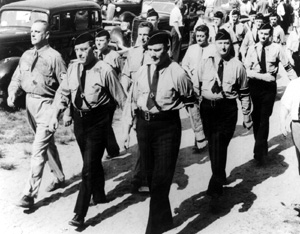
A
BYTE OUT OF HISTORY: 70 Years Ago
Rise of Fascism leads to FBI Casework
It was 1934, and the nation
was reeling from the Great Depression: unemployment stood at 24.9% and the
Dow-Jones average was sputtering from a low of 50 to a high of 108. Since
the ascent of Adolph Hitler to the position of Chancellor in Germany in January
1933, groups in America supporting his fascist ideology and Nazi vision had
become more and more vocal, claiming fascism could be the answer to American
woes.
President Roosevelt was
deeply concerned. Although the American Nazis seemed simply to be building
their party and espousing their ideology, Roosevelt suspected the groups
could be allying themselves to a foreign political movement that rejected
key parts of democratic governance. It was already clear in Germany that
the Nazis, after coming to power, were removing democratic safeguards there,
abrogating certain international treaties, and making noise about needing
more “living space,” which soon translated into capturing neighboring
lands.
The President
Calls A Conference
On May 9,1934, Roosevelt called a meeting at the White House to discuss the
situation. In attendance were Attorney General Homer Cummings, the Secretary
of Treasury, the Secretary of Labor, the Secret Service Chief, and FBI Director
J. Edgar Hoover.
Roosevelt posed the question: “should
the Nazi groups in the U.S. be investigated?” Conference members, weighing
the dangers, said yes—if legally possible. “But under what law?” It
was agreed that immigration laws offered solid grounds for investigating
the foreign connections of domestic groups—and the Bureau was given
the assignment, working with the Secretary of Immigration and with some assistance
from the Secret Service.
The Bureau Investigates
Back at FBI Headquarters, the order went out. Each FBI Field Office at once
formally opened an investigation in its geographical region into the intelligence
threats posed by domestic groups connected with Hitler’s Germany.
This initial effort was limited in scope and time: it sought to determine
only if foreign agents were working with the American Nazi groups.
Then, in 1936, under new
orders from President Roosevelt and Secretary of State Cordell Hull, the
Bureau opened new and more extensive investigations of fascist groups. These
were conducted under the newly passed Foreign Agents Registration Act, and
with substantial results. Through close counterespionage work, we uncovered
50 Nazi spies operating in America before the U.S. ever entered the war.
Links: See
more Bytes Out of FBI History on the FBI History
page.
